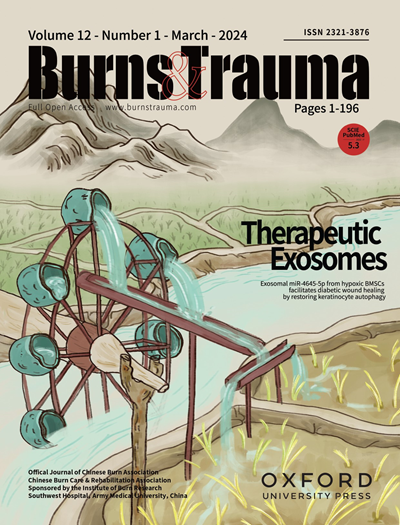基于聚乳酸的敷料,具有氧气生成和类酶活性,可加速光驱动的生物膜消除和伤口愈合
IF 9.6
1区 医学
Q1 DERMATOLOGY
引用次数: 0
摘要
背景光动力疗法(PDT)是根除感染伤口中细菌生物膜的一种广泛使用的治疗方法,但其有效性受到生物膜内缺氧环境的限制。本研究旨在探讨光动力清除生物膜的效率是否会因提供氧气(O2)而提高,以及参与感染伤口愈合的细胞因子的表达情况。方法 在石墨相氮化碳(g-C3N4,CN)纳米片上原位生长具有类似催化剂活性的二氧化锰(MnO2)纳米颗粒,构建一体化的CN-MnO2纳米酶,然后将其与聚左旋乳酸(PLLA)结合,通过电纺丝制备CN-MnO2/PLLA伤口敷料。随后,在808 nm近红外线和660 nm可见光照射下,通过铺板和水晶紫染色法检测了CN-MnO2/PLLA伤口敷料的体外抗菌生物膜比例和抗菌率。同时,建立了大鼠皮肤损伤模型,并对苏木精和伊红(H&E)、Masson's、肿瘤坏死因子-α(TNF-α)、精氨酸酶 1(Arg-1)、血管内皮生长因子(VEGF)和碱性成纤维细胞生长因子(BFGF)进行了体内评价,以评估 CN-MnO2/PLLA 伤口敷料对伤口愈合的影响。结果 使用 CN-MnO2/PLLA 敷料处理金黄色葡萄球菌和铜绿假单胞菌引起的生物膜密度,消除率分别为 83% 和 62%。此外,该敷料对这两种细菌都有很高的抗菌效果,对金黄色葡萄球菌和铜绿假单胞菌的清除率分别达到 99% 和 98.7%。此外,体内实验表明,CN-MnO2/PLLA 伤口敷料通过增加胶原蛋白沉积、抗炎细胞因子 Arg-1、血管生成细胞因子 VEGF 和上皮细胞 BFGF 的表达以及抑制炎症细胞因子 TNF-α 的表达,使感染伤口在第 14 天完全愈合,伤口愈合率达 >99% 。结论 CN-MnO2/PLLA伤口敷料在体外和体内均表现出优异的抗菌性能。此外,CN-MnO2/PLLA 伤口敷料还能通过抗炎、促进血管再生和皮肤组织重塑机制加速伤口快速愈合。本文章由计算机程序翻译,如有差异,请以英文原文为准。
Polylactic acid-based dressing with oxygen generation and enzyme-like activity for accelerating both light-driven biofilm elimination and wound healing
Background Photodynamic therapy (PDT) is a widely used therapeutic approach for eradicating bacterial biofilms in infected wound, but its effectiveness is limited by the hypoxic environment within the biofilm. This study aimed to investigate whether the efficiency of photodynamic removing biofilm is improving by providing oxygen (O2), as well as the expression of cytokines involved in infected wound healing. Methods Manganese dioxide (MnO2) nanoparticles with catalase-like activity were grown in situ on graphitic phase carbon nitride (g-C3N4, CN) nanosheets to construct an all-in-one CN-MnO2 nanozyme, which was then incorporated into poly-L-lactic acid (PLLA) to prepare CN-MnO2/PLLA wound dressing by electrospinning. Subsequently, the in vitro antibacterial biofilm ratio and antibacterial ratio of CN-MnO2/PLLA wound dressing were examined by spread plate and crystal violet staining under irradiation with 808 nm near-infrared light and 660 nm visible light. Meanwhile, the rat skin injury model was established, and hematoxylin and eosin (H&E), Masson’s, tumor necrosis factor-α (TNF-α), Arginase 1 (Arg-1), vascular endothelial growth factor (VEGF) and basic fibroblast growth factor (BFGF) were evaluated in vivo to assess the effect of CN-MnO2/PLLA wound dressing on wound healing. Results Biofilm density caused by Staphylococcus aureus and Pseudomonas aeruginosa had elimination rates of 83 and 62%, respectively, when treated with CN-MnO2/PLLA dressing. Additionally, the dressing exhibited high antibacterial efficacy against both bacteria, achieving 99 and 98.7% elimination of Staphylococcus aureus and Pseudomonas aeruginosa, respectively. Furthermore, in vivo experiments showed that the CN-MnO2/PLLA wound dressing achieved complete healing of infected wounds on Day 14, with a wound healing rate of >99% by increasing collagen deposition, expression of anti-inflammatory cytokine Arg-1, vascularization cytokine VEGF, and epithelial cell BFGF, and inhibiting the expression of inflammatory cytokine TNF-α. Conclusions The CN-MnO2/PLLA wound dressing exhibited excellent antibacterial properties in vitro and in vivo. In addition, CN-MnO2/PLLA wound dressing accelerated rapid wound healing through an anti-inflammatory, pro-vascular regeneration and skin tissue remodeling mechanism.
求助全文
通过发布文献求助,成功后即可免费获取论文全文。
去求助
来源期刊

Burns & Trauma
医学-皮肤病学
CiteScore
8.40
自引率
9.40%
发文量
186
审稿时长
6 weeks
期刊介绍:
The first open access journal in the field of burns and trauma injury in the Asia-Pacific region, Burns & Trauma publishes the latest developments in basic, clinical and translational research in the field. With a special focus on prevention, clinical treatment and basic research, the journal welcomes submissions in various aspects of biomaterials, tissue engineering, stem cells, critical care, immunobiology, skin transplantation, and the prevention and regeneration of burns and trauma injuries. With an expert Editorial Board and a team of dedicated scientific editors, the journal enjoys a large readership and is supported by Southwest Hospital, which covers authors'' article processing charges.
 求助内容:
求助内容: 应助结果提醒方式:
应助结果提醒方式:


